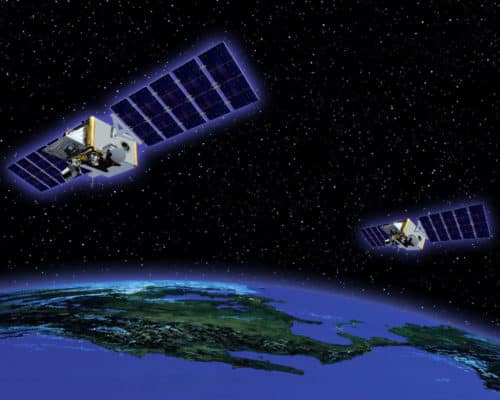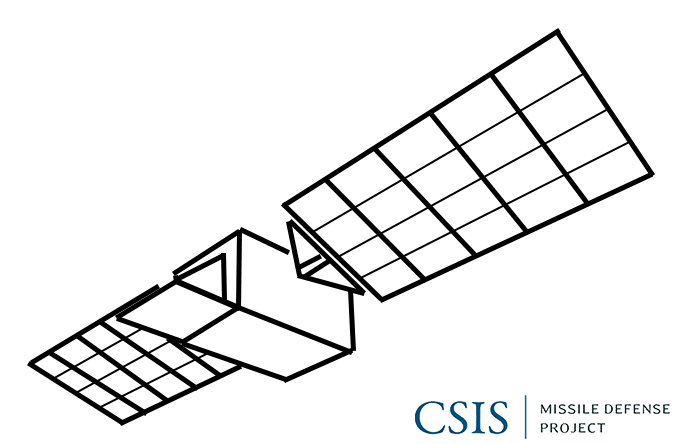The Space Tracking and Surveillance System (STSS) is a space-based system developed and operated by the Missile Defense Agency (MDA) that detects and tracks ballistic missiles. This system is an experimental component of the U.S. Ballistic Missile Defense System (BMDS) and STSS serves as a complement to other U.S. space-based platforms and was intended to be a precursor to a planned missile tracking constellation, the Precision Tracking Space System (PTSS).1
The aim of the Space Tracking and Surveillance System is to track missiles through all three phases of flight (boost, midcourse, and terminal); discriminate between warheads and decoys; transmit data to other systems that will be used to cue radars and provide intercept handovers; and provide data for missile defense interceptors to hit their target. According to the MDA Budget Justification from FY2010, “approximately fifty TPY-2 radars or approximately twenty Sea-Based X-Band radars (SBX) are required to provide the equivalent mid-latitude coverage of a spaced-based constellation.” Furthermore, the system provides “state vectors to C2BMC to enable interceptor fire control via multiple BMDS assets (AEGIS, GMD, THAAD).”2
Specifications
The STSS constellation orbits at 1,350km with a 58-degree incline and has a two-hour orbital period. The sensors on the two satellites detect visible and infrared light.3
The Space Tracking and Surveillance System has three main components: a wide-view acquisition sensor, a narrow-view tracking sensor, and a signal and data processor subsystem.4 The wide-view acquisition sensor will detect missiles during their boost phase. Once it reaches its midcourse phase, STSS follows its trajectory through space with a narrow-view tracker. While both the wide- and narrow-view sensors hone in on a missile, they send information to the system’s signal and data processor subsystem which is capable of sifting through some 2.1 gigabits of data per second. This subsystem can detect and track over 100 objects at a time and will be able to determine what objects in space are missiles or warheads and which are decoys or space debris.5
This information is then transmitted to ground command and control and disseminated.

Development History
The United States first began development of a constellation of low-orbiting satellites called Brilliant Eyes in the 1980s. This program was led by the Strategic Defense Initiative Office (SDIO) until 1996 when the program was transferred to the U.S. Air Force. Brilliant Eyes was folded into the SBIRS program, which was planned to replace the Defense Support Program (DSP). SBIRS was intended to have two components: Space-Based Infrared System-High (SBIRS-High) consisting of six satellites deployed 22,000 miles above the earth’s surface and a Space-Based Infrared System-Low (SBIRS-Low) component (formerly Brilliant Eyes) which would include twenty to thirty smaller satellites in low-earth orbit (LEO) no more than 930 miles above earth. In 2001, SBIRS-Low was transferred to the Missile Defense Agency (MDA) and in 2002 was renamed the Space Tracking and Surveillance System (STSS).6
The system is designed to provide dedicated birth-to-death tracking of missiles from space. This type of coverage makes the midcourse discrimination task easier because it allows the sensors to see where decoys deploy and debris is created, making it easier to pick out the warhead for an interceptor. The first two demonstration STSS-D satellites launched in September 2009.7
STSS’s demonstration satellites were initially funded in order to prove the system’s ability to track ballistic missiles and cue BMDS radars and interceptors. “The goal of an operational STSS is to track missiles through all three phases; discriminate between warheads and decoys; transmit data to other systems that will be used to cue radars and provide intercept handovers; and provide data for intercept hit/kill assessments.”8
In MDA Budget Justification for FY2010, they argue that, “The STSS Demonstrator satellites will demonstrate the ability of a space sensor to provide high precision, real time tracking of missiles and midcourse objects, thus enabling simultaneous regional, theater, and strategic missile defense. Data from STSS testing planned for FY10 will validate the ability to track cold, midcourse objects and close the fire control loop with BMDS interceptors from space. Additionally, STSS provides a new infrared sensor phenomenology for the BMDS, which, when combined with radars, provides robustness against current and advanced countermeasures.”9
In March 2011, the STSS-D demonstrated birth-to-death tracking of a test ballistic missile from space for the first time.10
This tracking and warning significantly expands the defended area by permitting “launch on remote,” the earlier launch of intercept missiles before the threat comes into view of an organic radar. In February 2013, the STSS-D satellites provided firing data to an Aegis destroyer for the first time during an intercept test of a medium-range ballistic missile.11
STSS was able to detect an incoming missile before terrestrial assets. This allows for launch on remote that allows multiple systems to work in tandem.12
The USS Lake Erie (CG-70) completed a successful intercept of a medium-range ballistic missile over the Pacific using detection and tracking data provided by STSS.13
STSS has undergone rigorous testing since 2009 and has demonstrated its ability to detect missile launches, track missiles from boost to mid-course, acquire and follow multiple targets simultaneously, communicate with currently used missile defense C2 systems, and send launch on remote cues to U.S. ships before it has the ability to detect the target independently.14
However, the STSS satellites in orbit were designed as experimental demonstration satellites with two-year design life. This has already been extended and, as of summer 2016, there are no plans to replace or launch additional satellites as part of the STSS constellation. MDA plans on keeping the STSS satellites operational until 2017. MDA’s follow-on program, the Precision Tracking Space System (PTSS), was cancelled by the Obama administration in FY2014.15
Footnotes
- “Space Tracking and Surveillance System,” Missile Defense Agency, July 28, 2016, http://www.mda.mil/global/documents/pdf/stss.pdf.
- Missile Defense Agency, Department of Defense Fiscal Year (FY) 2010 Budget Estimates: Research, Development, Test and Evaluation, Defense Wide, Volume 2, Exhibit R-2 (PE 0603893C), May 2009, http://comptroller.defense.gov/Portals/45/Documents/defbudget/fy2010/budget_justification/pdfs/03_RDT_and_E/Vol_2_MDA/PE-0603893C-STSS.pdf.
- “Space Tracking and Surveillance System,” Missile Defense Agency, July 28, 2016, http://www.mda.mil/global/documents/pdf/stss.pdf.
- “Flight Test Ground-Based Midcourse Defense -06b (FTG-06b),” (Report to Congress, July 11, 2014), http://www.dod.mil/pubs/foi/Reading_Room/MDA/15-F-0060_Flight_Test_Ground-Base_Midcourse.pdf.
- “STSS (Space Tracking and Surveillance System,” Forecast International, August 2010, https://www.forecastinternational.com/archive/disp_pdf.cfm?DACH_RECNO=795.
- Marcia S. Smith, Military Space Programs: Issues Concerning DOD’s SBIRS and STSS Programs (CRS Report No. RS21148), (Washington, DC: Congressional Research Service, January 30, 2006) http://www.au.af.mil/au/awc/awcgate/crs/rs21148.pdf.
- “Space Tracking and Surveillance System,” Missile Defense Agency, July 28, 2016, http://www.mda.mil/global/documents/pdf/stss.pdf.
- Marcia S. Smith, Military Space Programs: Issues Concerning DOD’s SBIRS and STSS Programs (CRS Report No. RS21148) (Washington, DC: Congressional Research Service, January 30, 2006), http://www.au.af.mil/au/awc/awcgate/crs/rs21148.pdf.
- Missile Defense Agency, Department of Defense Fiscal Year (FY) 2010 Budget Estimates: Research, Development, Test and Evaluation, Defense Wide, Volume 2, Exhibit R-2 (PE 0603893C), May 2009, http://comptroller.defense.gov/Portals/45/Documents/defbudget/fy2010/budget_justification/pdfs/03_RDT_and_E/Vol_2_MDA/PE-0603893C-STSS.pdf.
- Turner Britton, “STSS Satellites Demonstrate ‘Holy Grail’ of Missile Tracking,” Space News, March 23, 2011, http://spacenews.com/stss-satellites-demonstrate-holy-grail-missile-tracking/.
- Mike Gruss, “Satellites Play a Key Role in Successful Anti-missile Test,” Space News, February 13, 2013, http://spacenews.com/33652satellites-play-key-role-in-successful-anti-missile-test/.
- Amy Butler, “PTSS Kill Leaves Hole in Missile Defense Sensor Plan,” Aviation Week & Space Technology, April 29, 2013, http://aviationweek.com/awin/ptss-kill-leaves-hole-missile-defense-sensor-plan.
- “Aegis Ballistic Missile Defense Intercepts Target Using Space Tracking and Surveillance System-Demonstrators (STSS-D) Data,” Missile Defense Agency, February 13, 2013, http://www.mda.mil/news/13news0002.html.
- Missile Defense Agency, Department of Defense Fiscal Year (FY) 2010 Budget Estimates: Research, Development, Test and Evaluation, Defense Wide, Volume 2, Exhibit R-2 (PE 0603893C), May 2009, http://comptroller.defense.gov/Portals/45/Documents/defbudget/fy2010/budget_justification/pdfs/03_RDT_and_E/Vol_2_MDA/PE-0603893C-STSS.pdf.
- “Space Tracking and Surveillance System,” Missile Defense Agency, July 28, 2016, http://www.mda.mil/global/documents/pdf/stss.pdf.
